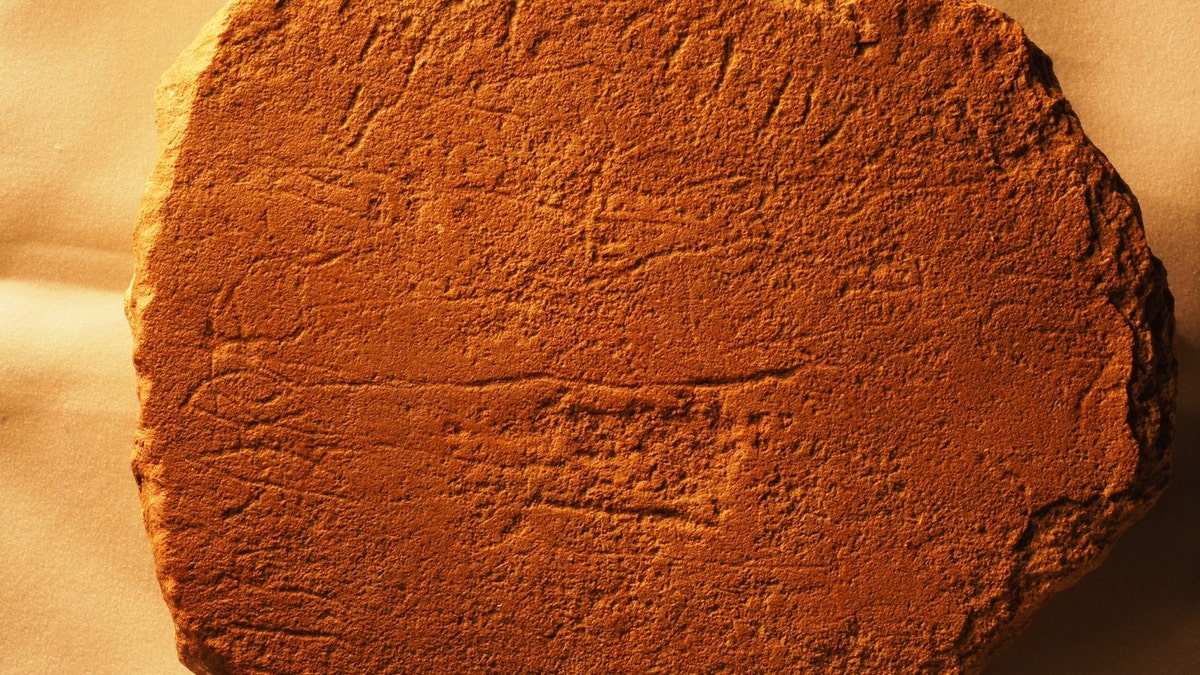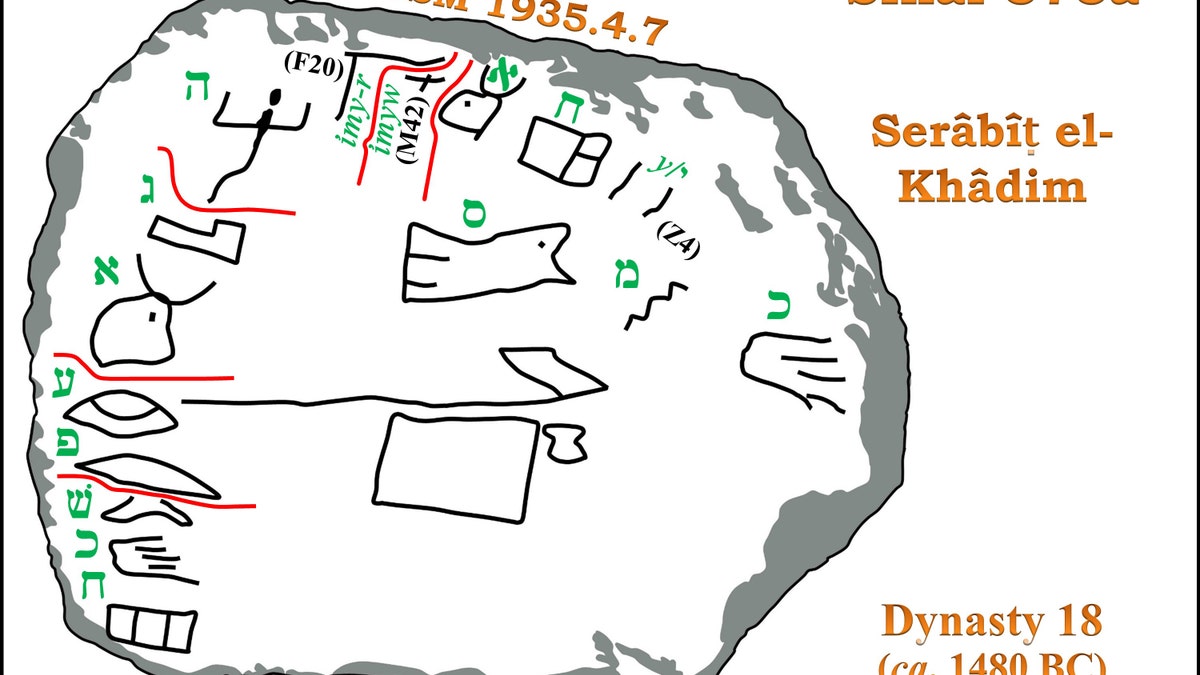
A photo of Sinai 375a, a stone slab from Egypt, which is now located in the Harvard Semitic Museum. This photo contains the name Ahisamach (Exodus 31:6) on the two horizontal lines. (Credit: Douglas Petrovich)
The oldest recorded alphabet may be Hebrew. According to a controversial new study by archaeologist and ancient inscription specialist Douglas Petrovich, Israelites in Egypt took 22 ancient Egyptian hieroglyphs and turned them into the Hebrew alphabet over 3,800 years ago.
The discovery of this early Hebrew alphabet has proved controversial to scholars who dispute the dates Petrovich has for the Israelites’ stay in Egypt – 430 years to the very day, as recorded in Exodus 12:40-41, equaling 1876-1446 BC – arguing that Biblical dates are unreliable. Skeptics have also disputed the Hebrew identification, arguing the early alphabet could be any number of Semitic languages.
The road to Petrovich’s discovery started back in 2012, when he was researching hieroglyphic inscriptions online from an Egyptian stone slab dated 1842 B.C. The slab, known as Sinai 115, identified Joseph and his sons Ephraim and Manasseh– all figures from the Hebrew Bible, the latter of whom inscribed the hieroglyphs on the slab himself. Something in the text Manasseh wrote– translation “6 Levantines: Hebrews of Bethel, the beloved,” which referred to himself, his son, and four other Hebrews on a turquoise mining expedition– caught the eye of Petrovich. It was the world’s oldest letter, he says.
STAR OF BETHLEHEM MAY NOT HAVE BEEN A STAR AFTER ALL, SCIENTIST SAYS
“On this otherwise Middle Egyptian caption were a Canaanite syllabic and the world’s oldest attested proto-consonantal letter–‘B’, depicting a house for the Hebrew consonant bayit,” Petrovich told Foxnews.com. “It was this single proto-consonantal Hebrew letter that helped me to understand that the world’s oldest alphabet, the language of which has been unidentified for over 150 years of scholarship, is Hebrew.”

Petrovich's electronic drawing of Sinai 375a, which includes the separation of words and identification of proto-consonantal letters with biblical/modern Hebrew letters next to them (Credit: Douglas Petrovich).
Petrovich, who currently teaches Ancient Egypt at Wilfred Laurier University, isn’t the first to identify Hebrew as the language of the world’s oldest alphabet. Back in the 1920’s, a German scholar named Hubert Grimme identified some of the inscriptions as Hebrew. However, unlike Petrovich, he was unable to identify all of the letters in the alphabet correctly. This led to failed translations and rejection by other scholars.
Putting together a complete alphabet, detailed in a soon–to–be–released book by Petrovich, was no easy task.
“I was translating Middle Egyptian and proto-consonantal Hebrew inscriptions that nobody ever had translated successfully before,” he said. “There were many ‘A-ha!’ moments along the way, because I was stumbling across biblical figures never attested before in the epigraphical record, or seeing connections that I had not understood before.”
ARCHAEOLOGISTS UNCOVER 'LOST CITY' IN EGYPT
Dividing words properly was also a hurdle because the letters all run together, without any spaces between them or punctuation.

Petrovich's electronic drawing of Sinai 351, a stone slab from Egypt, which describes how the Nile River had swollen to over twice its normal level after the year had changed, a catastrophic event that caused cultic shrines and watering troughs to become unclean due to contamination from silty river water (Credit: Douglas Petrovich).
After finally completing the alphabet, Petrovich was able to translate 16 Hebrew inscriptions from four different sites in Egypt and Sinai. In these inscriptions he found a number of distinctly Hebrew words, including the naming of 3 biblical figures: Asenath (the wife of Joseph), Ahisamach (the father of Oholiab, who was appointed to build the tabernacle in the desert), and Moses, who was credited by the Hebrew Bible as being the man who led the Israelites out of Egypt.
“I absolutely was surprised to find [the reference to] Moses, because he resided in Egypt for less than a year at the time of his provoking of astonishment there,” Petrovich recalled. “In fact, the Hebrew letters ‘M-Sh’ could have other meanings, and I had to examine every other possibility for those uses of Hebrew words with those letters. Only after realizing that every other possibility had to be eliminated, whether due to contextual or grammatical limitations, was I forced to admit that this word must be taken as a proper noun, and almost undoubtedly refers to the Moses who is credited with writing the first five books of the Hebrew Bible, known as the Torah.”
The inscription with the Moses reference dates back to 1446 or 1447 B.C.– the final year of the Israelites’ stay in Egypt– and describes events written about in Exodus 1, such as the enslavement of Hebrews. In the inscription, Moses is depicted as a man who inspired awe in the Hebrew community, which would match well with the biblical events describing Moses’ encounters with the pharaoh.
EARLIEST-KNOWN TEN COMMANDMENTS TABLET SELLS AT AUCTION FOR $850,000
Petrovich hopes that skeptics, instead of coming to pre–conclusions about his claims, will study his new findings with an open mind and be objective.
“My discoveries are so controversial because if correct, they will rewrite the history books and undermine much of the assumptions and misconceptions about the ancient Hebrew people and the Bible that have become commonly accepted in the scholarly world and taught as factual in the world’s leading universities,” he said. “To my skeptics, I say, ‘Continue to be skeptical. Do not accept my conclusions until you are convinced they are correct.’ Truth is un–killable, so if I am correct, my findings will outlast scholarly scrutiny.”
Further details can be found in Petrovich’s book “The World’s Oldest Alphabet” (Carta Books), which will be available in the coming weeks.
